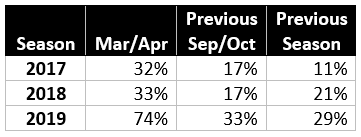Justin Verlander’s first inning pitched in more than 20 months required him to get through Shohei Ohtani, Mike Trout, and Anthony Rendon.
Verlander struck Ohtani and Rendon out. But it was Trout’s at-bat that foreshadowed what’s come for Verlander this season.
Trout cranked a 96-MPH fastball at the top of the zone to deep left center field.
And then this happened.
Chas McCormick’s leaping catch saved at least a double, maybe more (our Video Scouts did not deem it to be a home run robbery). Verlander ended up pitching five innings of one-run ball, the first of many successful starts in his return.
Verlander enters his start tonight with a 2.03 ERA and a 2.68 RA-9 compared to a 3.38 FIP. ERA/FIP differentials that large usually lead to questions about what the cause is.
In this case, we feel most of the difference can be explained with this stat:
No team’s defense has contributed more to their pitcher in fielding balls this season than the Astros has to Verlander.
Most Defensive Runs Saved for a Pitcher – From Positioning, Range, Throwing
| Name | Team | Runs Saved |
| Justin Verlander | Astros | 11.6 |
| Reid Detmers | Angels | 10.0 |
| Jordan Montgomery | Yankees | 9.9 |
| Cal Quantrill | Guardians | 8.9 |
| Beau Brieske | Tigers | 8.8 |
Now, when we say this, it’s important to point out that defense takes into account two things – the player’s positioning and the player’s skill in making the play.
Positioning
The Astros are a pretty aggressive team in maneuvering their infield defense. They rank 9th overall in how often they use any kind of infield shift (70% of balls in play have come against one) and 4th in how often they put three infielders on the pull side (47% of balls in play have been against one).
The payoff, at least for Verlander, comes on plays like these. Take note of the comments of the play-by-play announcer.
The Astros have just over 5 Positioning Runs Saved for Verlander this season. There are other teams with about that many – the Cardinals for Adam Wainwright and the Red Sox for Michael Wacha among them.
What makes the Astros’ defense for Verlander distinct is how their skill factors in.
Skill
This play is a good example of one that literally saved a run for Verlander.
Defensive Runs Saved operates in a more theoretical world estimating Runs Saved values from the out probabilities of every play made and not made. It doesn’t consider the context in which the play was made (in other words, man on second base, two outs).
That play had a 36% out probability for the team and was worth 0.49 Runs Saved Runs Saved.
McCormick’s catch on Trout, the play referenced at the beginning of this article, was a 46% catch probability and was worth 0.56 Runs Saved.
Verlander has had his share of nice defensive plays behind him this season. Take his last start against the Mets, which featured three of what we call Good Fielding Plays (one resulting in injuries, since healed, to Jeremy Pena and Yordan Alvarez).
In sum, the out-making skill of the Astros defense has saved Verlander 6.5 runs.
There are other teams that have saved that many runs for their pitchers with their defensive skill. But none has combined skill and positioning like the Astros have for their ace.
What’s funny is that we wrote a similar piece on Verlander and his defense in 2019. As Verlander has moved into the end phase of his Hall of Fame career, he’s needed a little help to last as long and be as effective as he has. He seems to be on the right team for that.


